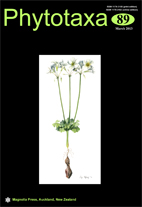Abstract
The Bothriochloa saccharoides complex is one of the most interesting groups within the genus Bothriochloa (Poaceae). The plants inhabit grasslands of tropical and subtropical regions from the Americas. Principal components analysis (PCA) and discriminant analysis (DA) were employed to evaluate the morphological variation among 60 herbarium specimens tentatively identified as B. imperatoides, B. laguroides, B. longipaniculata, B. saccharoides and B. torreyana. Twenty-three morphological characters were included in the analysis in order to clarify problematic species boundaries. Chemical data was incorporated to improve the resolution on delimitation of the species complex. Taxa were delimited according to the observed clustering of specimens in the PCA plots and discriminant analysis, and diagnostic characters were identified. The results showed that five taxa could be distinguished on the basis of morphological characters and chemical data. Two new subspecies are described: B. saccharoides subsp. americana and B. saccharoides subsp. australis. An identification key and a taxonomic synopsis are provided.

